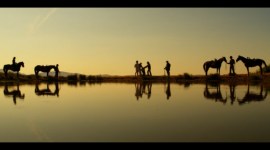
Finding Content for the Instagram Creator
The hardest part of content creation isn’t making money, it’s finding a subject that inspires. Here’s how one photographer found fulfillment on the track.

I’ve always been a publishing person, a news junkie, and a writer that needed a reader. Becoming a social media creator was a scratch I was itching for.
But in addition to the joy of creating content for this account, I was prepared for the Faustian pact that I was entering into, where the continued and obsessive chase for followers and self-validity shadows your every move.
So this summer, I decided to start a project on Instagram, taking inspiration from a family friend who had taken his surfing account to impressive levels of interest (see thesurfbank). He found a subject he was already deeply invested in and young enough to appreciate and so revel in its culture.
I needed an idea where I could use my journalistic, photography, and videography skills but didn’t need and wasn’t looking for commercial involvement, as I thought that could skew my vision for the project.
I decided to look into horse racing, especially the home of flat racing in the UK, which has the small town of Newmarket in Suffolk as its epicenter. I live near there, close enough to immerse myself into this unique world of thoroughbred horses and horse folk.

What Content is Available?

Horse racing in Newmarket has been going on since the mid-1600s. Now there are thousands of racehorses training here with stud farms and bloodstock agencies creating the next champions.
There are at least 100 vets here just for the horses and two horse hospitals that will take in lame horses the day they are diagnosed. There is no waiting for these thoroughbreds.

Hundreds of young people from all over the world are also plying their trade here. They staff the yards; they ride out every day, rain or shine, to sustain the condition of the horses. These guys and girls also have to keep themselves supremely fit and keep to a weight to keep their jobs; there are plenty of sacrifices. Then there are all the ancillary companies, the farriers, the horse transporters, the racewear companies, and many more.
So, you have this heady mix of good-looking young people, beautiful and often highly-strung horses cantering at high speeds, and a highly professional sport worth billions. Every day this drama unfolds from around 6.30 am to 11.30 am, Monday to Saturday, in front of your eyes. All through the town streets, all on their way to the number of gallops that the town offers.
Think street photography with racehorses and their riders across an intense five hours daily. If I wanted to capture this community, I would have to use street tactics and look for candid shots, and risk being shouted at by some very tough and seasoned individuals riding some very expensive horse flesh.
The Gear I Started With
Instagram was the apparent choice for @newmarket_horsetown. You had a platform based on visuals, and their Reels feature encouraged some videography, albeit at a 9:16 aspect ratio.
I needed to buy cameras and look for value. I wasn’t looking to earn from this personal project, so I had a strict budget. I wanted to shoot horses at speed, so I needed a proven sports model camera at a few-hundred-pound price. I also required zoom lenses that kept me invisible, as being on the health while training is out of bounds for public access. I was to break that rule quickly.
I bought a Nikon D3, a 15-year-old full-frame photography-only camera. In its day, this was a great full-frame sports camera with two levels of burst mode, with the highest mode only offering around five Raw photos at a time. I bought a Nikkor 85mm 1.8 G lens and a Tamron 70-300mm F4 with VC—Vibration Compensation. I spent around £700 ($1000) for everything with media cards.
But what about video? My D3 didn’t have any video capability, and an iPhone wouldn’t offer telephoto help even though they’re perfect for Instagram’s 9:16 aspect ratio for their Reels. My budget was only around £300 ($500). I asked a lot, but ended up looking at a Panasonic Lumix GH4.
The GH4 was only recently dropped by B&H Photo, such was its popularity. It offers a 4K performance at 24fps, a reasonable slow motion option that tops out at 1080/96fps and then transcodes in camera.
Panasonic has excellent build quality and menus full of broadcast-based features. But, it does need work to get a good result. Video cameras have evolved quicker than still cameras in the last ten years. Now, with only an iPhone, you can get an excellent and bright stabilized 4K video quality that will beat an old camera like this without any problem, and everyone has an iPhone or equivalent.
Since buying the GH4, I’ve added a Metabones adapter to use my Nikkor 85mm lens with it. That turns the lens into a perhaps f1.0 at around 100mm, so tricky to focus with. The GH4 also doesn’t have any image stabilization, so you need a tripod that will limit your movement—or a gimbal, which is more money and might frighten the horses when you move with it.
Building an Instagram Account

I’ve been shooting for the account for over two months now and have over 570 followers. My initial idea was to cover the community in a documentary fashion, but I quickly realized that followers wanted to see who else was out on the training grounds.
I was soon being DM’d about whether I had photos of the people messaging me. People were identifying others they knew in the comments without any encouragement from me.
Hence, I started pushing out primarily photographs of the jockeys daily and in blocks of ten, which is Instagram’s limit on posts. This blanket coverage started returning results with fast follower uptake.
I also contacted the yards to see if I could visit them and take photographs and videos of their work day. This worked well, and the staff welcomed me. I started awarding photos of the month and would visit the winners with a framed print of the photographs they were in.
Now the weather is getting colder for those 6.30 am starts, and I’m wondering what to do with my Instagram project. There are plenty of people who don’t like my paparazzi-type style but also plenty who will commend me on the account.
There is great satisfaction in shooting such content; covering more of the yards is definitely the way to go. If I get to 1000 followers, that is some validation of what I’m doing. But also, not having a monetary interest in the account’s success allows me to pack it up at a moment’s notice.
See Newmarket_horsetown on Instagram.
For more Instagram tips, check out the following articles.
- How to Upload 60-Second Videos to Instagram
- Instagram Reels, Finally a TikTok Competitor?
- How Will Instagram Influence the Filmmakers of Tomorrow?
- The 7 Rules for Creating Instagram-Ready Video Content





